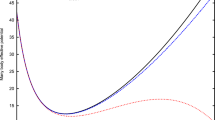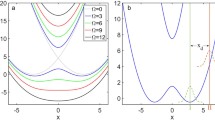Abstract
We study two-component Bose–Einstein condensates (BECs) with electromagnetically induced attractive monopolar interaction, by means of the Dirac–Frenkel–McLachlan variational principle. The effectiveness of external trap potential, inter-component \(s\)-wave scattering, monopolar interaction, and particle numbers on the density of BECs is investigated. It is shown that the trap potential dramatically affects density profiles compared to the other three ingredients. Atoms with smaller intra-component \(s\)-wave scattering length will be squeezed out when monopolar interaction or particle numbers are small, whereas the atoms in the other component are pushed out instead when either parameter is large enough. This is in contrast to modulation of inter-component \(s\)-wave scattering length, which can not exchange the relative location of different components.






Similar content being viewed by others
References
I. Bloch, J. Dalibard, W. Zwerger, Many-body physics with ultracold gases. Rev. Mod. Phys. 80, 885 (2008)
A. Griesmaier, J. Werner, S. Hensler, J. Stuhler, T. Pfau, Bose–Einstein condensation of chromium. Phys. Rev. Lett. 94, 160401 (2005)
A. Griesmaier, J. Stuhler, T. Koch, M. Fattori, T. Pfau, S. Giovanazzi, Comparing contact and dipolar interactions in a Bose–Einstein condensate. Phys. Rev. Lett. 97, 250402 (2006)
T. Lahaye, C. Menotti, L. Santos, M. Lewenstein, T. Pfau, The physics of dipolar bosonic quantum gases. Rep. Prog. Phys. 72, 126401 (2009)
D. O’Dell, S. Giovanazzi, G. Kurizki, V.M. Akulin, Bose–Einstein condensates with \(1/r\) interatomic attraction: electromagnetically induced “gravity”. Phys. Rev. Lett. 84, 5687 (2000)
S. Rau, J. Main, P. Köberle, G. Wunner, Pitchfork bifurcations in blood-cell-shaped dipolar Bose–Einstein condensates. Phys. Rev. A 81, 031605(R) (2010)
H. Cartarius, T. Fabčič, J. Main, G. Wunner, Dynamics and stability of Bose–Einstein condensates with attractive \(1/r\) interaction. Phys. Rev. A 78, 013615 (2008)
I. Papadopoulos, P. Wagner, G. Wunner, J. Main, Bose–Einstein condensates with attractive \(1/r\) interaction: the case of self-trapping. Phys. Rev. A 76, 053604 (2007)
T. Ho, V. Shenoy, Binary mixtures of bose condensates of alkali atoms. Phys. Rev. Lett. 77, 3276 (1996)
H. Pu, N. Bigelow, Properties of two-species bose condensates. Phys. Rev. Lett. 80, 1130 (1998)
V. Schweikhard, I. Coddington, P. Engels, S. Tung, E.A. Cornell, Vortex-lattice dynamics in rotating spinor Bose–Einstein condensates. Phys. Rev. Lett. 93, 210403 (2004)
K.M. Mertes, J.W. Merrill, R. Carretero-González, D.J. Frantzeskakis, P.G. Kevrekidis, D.S. Hall, Nonequilibrium dynamics and superfluid ring excitations in binary Bose–Einstein condensates. Phys. Rev. A 99, 190402 (2007)
S.B. Papp, J.M. Pino, C.E. Wieman, Tunable miscibility in a dual-species Bose–Einstein condensate. J. Chem. Phys. 101, 040402 (2008)
Kui-Tian Xi, Jinbin Li, Da-Ning Shi, Phase separation of a two-component dipolar Bose–Einstein condensate in the quasi-one-dimensional and quasi-two-dimensional regime. Phys. Rev. A 84, 013619 (2011)
H. Saito, Y. Kawaguchi, M. Ueda, Ferrofluidity in a two-component dipolar Bose–Einstein condensate. Phys. Rev. Lett. 102, 230403 (2009)
G. Gligorić, A. Maluckov, M. Stepić, L. Had\(\breve{z}\)ievski, B. Malomed, Transition to miscibility in linearly coupled binary dipolar Bose–Einstein condensates. Phys. Rev. A 82, 033624 (2010)
S. Ronen, D.C.E. Bortolotti, J.L. Bohn, Bogoliubov modes of a dipolar condensate in a cylindrical trap. Phys. Rev. A 74, 013623 (2006)
E.J. Heller, Classical S-matrix limit of wave packet dynamics. J. Chem. Phys. 65, 4979 (1976)
F. Gaussians, A very simple semiclassical approximation. J. Chem. Phys. 75, 2923 (1981)
P. Dirac, Note on exchange phenomena in the Thomas Atom. Math. Proc. Cambridge Philos. Soc. 26, 376 (1930)
A.D. McLachlan, A variational solution of the time-dependent Schrodinger equation. Mol. Phys. 8, 39 (1964)
M.J.D. Powell, A hybrid method for nonlinear equations, in Numerical methods for nonlinear algebraic equations, ed. by P. Rabinowitz (Gordon and Breach, London, 1970), pp. 87–114
W.H. Press, S.A. Teukolsky, W.T. Vetterling, B.P. Flannery, Numerical recipes in FORTRAN, 2nd edn. (Cambridge University Press, Cambridge, 1992), pp. 387–448
Acknowledgments
This work is supported by the National Natural Science Foundation of China (NSFC, Grant No.11104143).
Author information
Authors and Affiliations
Corresponding author
Rights and permissions
About this article
Cite this article
Li, J., Qiao, Y. Properties of Two-Component Bose–Einstein Condensates with Monopolar Interaction. J Low Temp Phys 177, 165–177 (2014). https://doi.org/10.1007/s10909-014-1207-4
Received:
Accepted:
Published:
Issue Date:
DOI: https://doi.org/10.1007/s10909-014-1207-4




